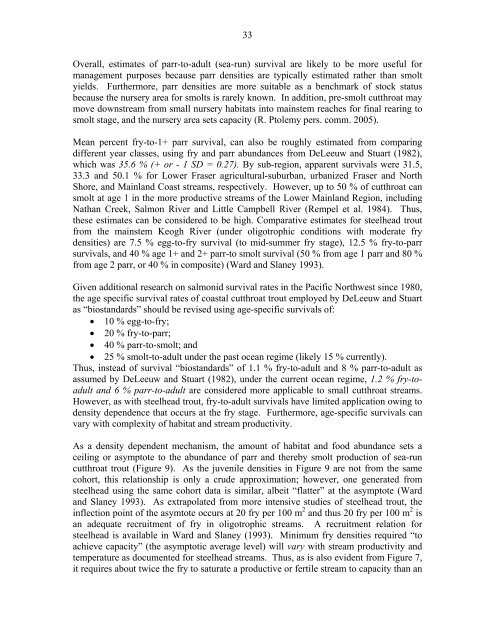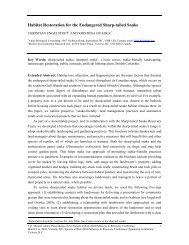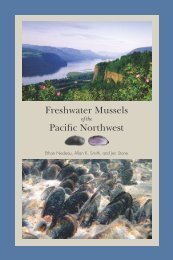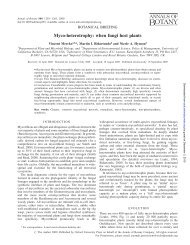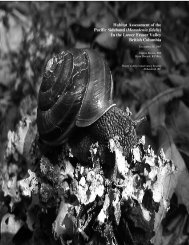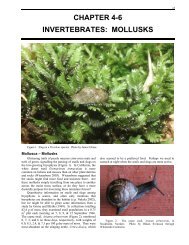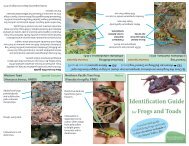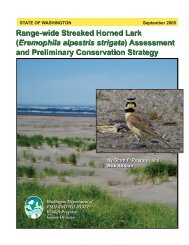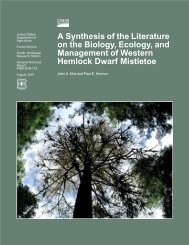Coastal Cutthroat Trout as Sentinels of Lower Mainland Watershed ...
Coastal Cutthroat Trout as Sentinels of Lower Mainland Watershed ...
Coastal Cutthroat Trout as Sentinels of Lower Mainland Watershed ...
Create successful ePaper yourself
Turn your PDF publications into a flip-book with our unique Google optimized e-Paper software.
33Overall, estimates <strong>of</strong> parr-to-adult (sea-run) survival are likely to be more useful formanagement purposes because parr densities are typically estimated rather than smoltyields. Furthermore, parr densities are more suitable <strong>as</strong> a benchmark <strong>of</strong> stock statusbecause the nursery area for smolts is rarely known. In addition, pre-smolt cutthroat maymove downstream from small nursery habitats into mainstem reaches for final rearing tosmolt stage, and the nursery area sets capacity (R. Ptolemy pers. comm. 2005).Mean percent fry-to-1+ parr survival, can also be roughly estimated from comparingdifferent year cl<strong>as</strong>ses, using fry and parr abundances from DeLeeuw and Stuart (1982),which w<strong>as</strong> 35.6 % (+ or - 1 SD = 0.27). By sub-region, apparent survivals were 31.5,33.3 and 50.1 % for <strong>Lower</strong> Fr<strong>as</strong>er agricultural-suburban, urbanized Fr<strong>as</strong>er and NorthShore, and <strong>Mainland</strong> Co<strong>as</strong>t streams, respectively. However, up to 50 % <strong>of</strong> cutthroat cansmolt at age 1 in the more productive streams <strong>of</strong> the <strong>Lower</strong> <strong>Mainland</strong> Region, includingNathan Creek, Salmon River and Little Campbell River (Rempel et al. 1984). Thus,these estimates can be considered to be high. Comparative estimates for steelhead troutfrom the mainstem Keogh River (under oligotrophic conditions with moderate frydensities) are 7.5 % egg-to-fry survival (to mid-summer fry stage), 12.5 % fry-to-parrsurvivals, and 40 % age 1+ and 2+ parr-to smolt survival (50 % from age 1 parr and 80 %from age 2 parr, or 40 % in composite) (Ward and Slaney 1993).Given additional research on salmonid survival rates in the Pacific Northwest since 1980,the age specific survival rates <strong>of</strong> co<strong>as</strong>tal cutthroat trout employed by DeLeeuw and Stuart<strong>as</strong> “biostandards” should be revised using age-specific survivals <strong>of</strong>:• 10 % egg-to-fry;• 20 % fry-to-parr;• 40 % parr-to-smolt; and• 25 % smolt-to-adult under the p<strong>as</strong>t ocean regime (likely 15 % currently).Thus, instead <strong>of</strong> survival “biostandards” <strong>of</strong> 1.1 % fry-to-adult and 8 % parr-to-adult <strong>as</strong><strong>as</strong>sumed by DeLeeuw and Stuart (1982), under the current ocean regime, 1.2 % fry-toadultand 6 % parr-to-adult are considered more applicable to small cutthroat streams.However, <strong>as</strong> with steelhead trout, fry-to-adult survivals have limited application owing todensity dependence that occurs at the fry stage. Furthermore, age-specific survivals canvary with complexity <strong>of</strong> habitat and stream productivity.As a density dependent mechanism, the amount <strong>of</strong> habitat and food abundance sets aceiling or <strong>as</strong>ymptote to the abundance <strong>of</strong> parr and thereby smolt production <strong>of</strong> sea-runcutthroat trout (Figure 9). As the juvenile densities in Figure 9 are not from the samecohort, this relationship is only a crude approximation; however, one generated fromsteelhead using the same cohort data is similar, albeit “flatter” at the <strong>as</strong>ymptote (Wardand Slaney 1993). As extrapolated from more intensive studies <strong>of</strong> steelhead trout, theinflection point <strong>of</strong> the <strong>as</strong>ymtote occurs at 20 fry per 100 m 2 and thus 20 fry per 100 m 2 isan adequate recruitment <strong>of</strong> fry in oligotrophic streams. A recruitment relation forsteelhead is available in Ward and Slaney (1993). Minimum fry densities required “toachieve capacity” (the <strong>as</strong>ymptotic average level) will vary with stream productivity andtemperature <strong>as</strong> documented for steelhead streams. Thus, <strong>as</strong> is also evident from Figure 7,it requires about twice the fry to saturate a productive or fertile stream to capacity than an


